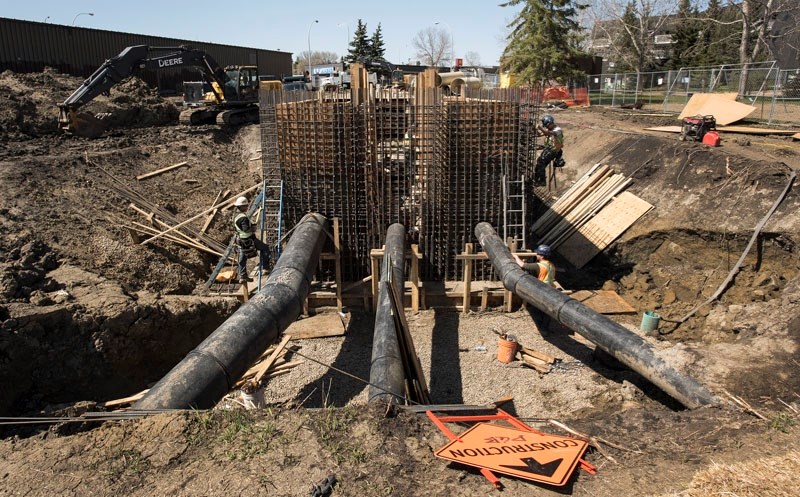The open excavation and relocation of the St. Albert Centre bus terminal leaves no doubt that Project 9 construction is underway.
But as crews prepare to install the sewer trunk line south of the Sturgeon River, residents may be hard pressed to find any signs of construction work thanks to new methods called trenchless technologies.
Construction methods aren’t typically named for what they don’t accomplish, but in this case the ability to install service lines like water or gas pipes and electric or telecommunications cables without having to dig a continuous, and oftentimes disruptive, trench is the whole point.
Trenchless technologies allow the installation, replacement or renewal of underground utilities with minimum excavation or surface disruption.
While some methods have existed for over a century, early applications focused on mineral exploration and coal mining. It wasn’t until the mid-20th century that no-dig approaches were considered for construction purposes.
With urbanization and densification increasing service demand, but also making access and installation increasingly difficult these technologies became more and more developed and commonplace.
“When you get into these areas where there are existing houses and residential and people have vested interest, that’s when these trenchless technologies are really coming into play,” said Paul Dedeluk, an engineer with Associated Engineering.
There are a number of different methods that fall under the umbrella of trenchless tech. St. Albert is using two to install the sanitary sewer line known in the community as Project 9. Horizontal directional drilling was used to install pipe beneath the Sturgeon River, while micro tunnelling will be used to install 2.5 kilometres of pipe south of the river starting next month.
Micro tunnelling is a highly automated remote control technique. A micro tunnel boring machine (MTBM) is lowered into a shaft and used to cut through the soil, while simultaneously pulling pipe through the tunnel.
The boring machine moves at a speed of 0.5 metres per hour and displaces soil by grinding it up and mixing it with water. The mixture is discharged above ground and the water is cleaned and reused.
There are many advantages to using trenchless technology – namely it’s less disruptive than the traditional open cut method, currently being used to install the Rivercrest portion of the line.
Though minimizing impact on residents was at the heart of the city’s planning efforts, a much more practical factor influenced the decision to use microtunnelling: depth.
The $25-million line will connect the sanitary sewer system north of the Sturgeon River to the lift station at Sturgeon Road and Sir Winston Churchill Avenue. These points predetermine the elevation of the line, which will cross the St. Vital Avenue and St. Albert Trail intersection, travel north down Rivercrest Crescent before crossing the river and travelling eastward along Sturgeon Road to its endpoint.
Due to St. Albert’s hilly topography the pipe will be as deep as 13 metres (40 feet) underground in some areas.
“As soon as you go down to that kind of depth a traditional excavation would just excavate too large of an area to mitigate those impacts (on residents),” said city engineer Kate Polkovsky.
Since a trench needs to be dug using 1:1 slope gradient – one metre out for every metre down – an open cut trench method would have resulted in the closure of all four lanes of traffic on Sturgeon Road.
Instead residents will only experience partial closures (with traffic reduced to one lane in each direction) to accommodate the six-metre wide shafts.
Depth is also the reason the city is using a traditional open cut trench method for Rivercrest Crescent. Trenchless digging requires a minimum cover to ensure soil strength and the elevation in this area is too shallow.
Trenchless technology has become commonplace in the construction and engineering world. St. Albert has used horizontal directional digging to install numerous water lines beneath the Sturgeon River in the past five years and microtunnelling was used in the first phase of Project 9, completed in 2009.
What makes this project unique is the scale. Worldwide, this is a tiny project, but for St. Albert “this is a big pipe” said Polkovsky. The line measures three kilometres in length and is 1.5 metres in diameter.
Typical sewer lines measure 300 to 600 millimetres in diameter and aren’t nearly as long. In comparison, Dedeluk is overseeing another micro tunnelling project that will see 600 metres of pipe installed in Grandin over the course of one summer.
Another unique aspect of Project 9 is that construction will not halt when summer ends. Unlike open cut installations, micro tunnelling can continue year-round, which significantly cuts down the construction timeline and allows for continued use of the Legion Memorial Ball Park and the botanic park during the summer months.
“We planned the whole construction staging so that we don’t interfere with community groups,” said Dedeluk.
Work in and around the Red Willow Park trail system is planned for the winter.
Though a number of trees did need to be cut down to accommodate the staging area along Rivercrest Crescent, trenchless tech’s compact footprint helps minimize environmental impacts by limiting excavation, clear cutting and runoff.
The work at Rivercrest Crescent is expected to wrap up by the end of the summer, while tunnelling along Sturgeon Road, west of Boudreau Road will end by the end of 2017. The work east of Boudreau, including connecting to the lift station, will take place in 2018.
Connecting the completed line to the existing infrastructure near the intersection of St. Vital Avenue and St. Albert Trail is expected to occur in late 2018.
Project 9 is needed to increase St. Albert’s wastewater capacity before further development in the city’s north and west ends including the Employment Lands.



